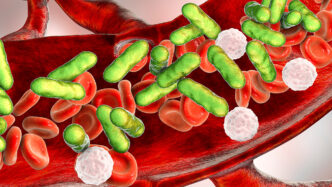No parents want to see their child in discomfort, especially from the food they eat. You may notice that your toddler is showing signs of food allergies and wonder why. Well, food allergies are commonly developed during the early stages of life, particularly from infancy to around two years of age.
WORDS AINA SHAFIQAH ZARISMAIL AND DR HASLINA ABDUL HAMID
 FEATURED EXPERT FEATURED EXPERTAINA SHAFIQAH ZARISMAIL Master’s Student in Clinical Nutrition Faculty of Health Sciences Universiti Kebangsaan Malaysia (UKM) |
 FEATURED EXPERT FEATURED EXPERTDR HASLINA ABDUL HAMID Senior Lecturer and Registered Dietitian and Nutritionist Centre for Community Health Studies (ReaCH) Faculty of Health Sciences Universiti Kebangsaan Malaysia (UKM) |
FACTS ABOUT FOOD ALLERGY
- Food allergy is a response from the body’s immune system to certain food proteins that it mistakenly identifies as harmful.
- Young children are particularly vulnerable to developing food allergies because their immune and digestive systems are still maturing.
- This is especially true after six months of age, when solid foods are introduced and the gut is still sensitive.
- The most common food allergens in children include tree nuts, eggs, cow’s milk and shellfish.
Food Allergy Is Different from Food Intolerance
Food intolerance happens when your digestive system has difficulty in digesting certain foods.
For example, if you often feel bloated or have a stomach-ache after drinking cow’s milk, you might have lactose intolerance, which is different from cow’s milk allergy.
Different Foods Trigger Different Allergic Reactions
- The reason lies in the specific proteins found in those foods.
- Depending on how a person’s immune system responds to these proteins, food allergies may cause either an immediate response or a delayed response.
Immediate response
- The immediate response is caused by antibodies known as immunoglobulin E (IgE), which
mistakenly identify certain food proteins as harmful. - In response to the action of IgE, the body releases a chemical called histamine, which leads to allergy symptoms like skin rashes, swelling, or a severe reaction called anaphylaxis.
- These symptoms can appear within minutes to 2 hours after consuming the trigger food.
- This type of allergic reaction more commonly observed in young children compared to the delayed reactions.
Delayed response
- Delayed allergic responses are triggered by other immune cells.
- IgE antibodies are not involved.
- These responses may cause symptoms such as bloating as well as diarrhoea or eczema flare-ups.
- These symptoms can appear between hours and days after eating the trigger food.
- Since the allergy reaction is delayed, it can be more challenging to identify the specific trigger food.
HOW CAN YOU MANAGE YOUR CHILD’S FOOD ALLERGY?
Most parents choose to exclude the trigger foods from their child’s diet.
- This is often the safer and simpler approach.
- This approach also follows current recommendation, which suggests avoiding known food allergens to reduce the risk of adverse allergic reactions.
- For instance, your child is allergic to eggs, you might want to go for soft tofu as an alternative source of protein.
| For children with cow’s milk allergy, where breast milk is not an option, a hypoallergenic extensively hydrolyzed formula is usually recommended. These formulas are designed with modified protein structure to prevent allergic responses while still providing sufficient nutrients. |
Parents can also opt for oral immunotherapy (OIT) for their child.
- The child will be exposed to the allergen at regular intervals; this is conducted in a hospital setting.
- This helps gradually build the child’s tolerance towards the trigger food, so over time they can consume it without experiencing any adverse effects.
- OIT is typically used for allergies to egg, cow’s milk and peanuts.
- However, many children naturally outgrow allergies to egg and cow’s milk by early childhood, so OIT may not always be necessary.
- Moreover, the treatment requires frequent clinic visits and long-term monitoring, which can be costly and time-consuming — making it less practical for some families in managing food allergies.
While excluding food allergens might seem like the simpler solution, but without proper
substitutes, eliminating these foods can affect your child’s growth.
Hence, that’s why it’s crucial to understand what nutrients these allergens provide, and how their absence might impact your child’s health.
HOW FOOD ALLERGIES AFFECT A CHILD’S GROWTH
- Recent findings have shown that children with cow’s milk allergies who do not receive appropriate dietary substitutions are at higher risk of being undernourished.
- Another study found that children with food allergies are more likely to be underweight compared to their peers.
This shows that when allergens are removed without proper replacement, a child’s growth and development may be compromised.
- Common food allergens like eggs, cow’s milk, shellfish and peanuts provide a wide range of important nutrients.
- These nutrients play a critical role during early childhood, a crucial period for physical growth and brain development.
Completely eliminating these foods without appropriate substitutes may negatively impact a child’s growth, potentially leading to:
- Failure to thrive, when a child isn’t gaining weight or growing as expected for their age
- Weakened immunity
- Delayed physical development

Calcium
- Cow’s milk is a rich and accessible source of calcium, which is essential for building strong bones.
- If you completely remove cow’s milk from your child’s diet, it can increase your child’s risk of rickets, a condition where bones become weak and fragile over time.
- Studies have shown that children with cow’s milk allergy are more likely to weigh less for their age, especially if they don’t receive suitable dietary substitutions.
Protein
- Common food allergens like eggs and shellfish are great sources of high-quality protein, which
is vital for tissue growth and repair. - If these foods are removed or restricted without proper alternatives, there is a risk of protein deficiency that will affect growth, muscle development and immune function.
- A lack of protein intake may lead to muscle loss, reduced weight, and shorter height compared to other children.
Vitamin B12
- Vitamin B12, often referred as cobalamin, is an essential B vitamin that plays a vital role in
DNA synthesis. - The primary sources of vitamin B12 are animal-source foods such as eggs, shellfish, or cow’s milk.
- A lack of vitamin B12 would affect brain development that occur actively during early childhood,
- This could negatively impact their cognitive function and psychomotor skills over time.
WHAT PARENTS CAN DO TO SUPPORT THEIR ALLERGIC CHILD’S GROWTH AND DEVELOPMENT
Seek Proper Diagnosis from Healthcare Professionals
- If you suspect that your child is allergic to certain foods, the first step is to visit the
hospital and get a proper diagnosis from a paediatrician or allergist. - Infants and toddlers are more prone to developing food allergies, so it’s important to introduce new foods carefully and track any allergic reactions.
Learn to Read Food Labels Carefully
- Always check the ingredients lists for presence of allergens such as milk or nuts, especially in packaged or baked goods.
- You might want to look for “may contain…” or “processed in a facility that handles…” warnings on the food packaging to reduce the risk of cross-contamination.
Provide Appropriate Dietary Substitutes
To ensure your child gets sufficient nutrients, replace the allergenic foods with safe
alternatives. For instance:
Cow’s milk allergy
- Replace cow’s milk with hypoallergenic formula, based on the doctor or dietitian’s
recommendation. - Swap cow’s milk to plant-based milk like soy or oat milk; choose options that are fortified with vitamin D and calcium to support healthy bone development.
Nut allergy
- Introduce chia seeds if your child is allergy to tree nuts, as chia seeds are rich in alphalinolenic acid – an omega-3 fatty acid.
Chicken egg allergy
- Switch chicken eggs with soft tofu or tempeh.
Keep a Food Journal
- Keep track of what your child eats throughout the day.
- Keeping a food record can be helpful when it comes to identifying potential causes of growth issues.
Regularly Monitor Your Child’s Growth Pattern
- Schedule regular check-ups with healthcare professionals such as paediatrician or dietitian.
- These visits help assess growth, dietary adequacy, and the need for further intervention or supplementation.
| This article is part of our series on a child’s nutrition as well as their healthy growth and development. |
References:
-
Akarsu, A., Brindisi, G., Fiocchi, A., Zicari, A. M., & Arasi, S. (2022). Oral immunotherapy in food allergy: A critical pediatric perspective. Frontiers in Pediatrics, 10, 842196. https://doi.org/10.3389/fped.2022.842196
-
D’Auria, E., Salvatore, S., Acunzo, M., Peroni, D., Pendezza, E., Di Profio, E., Fiore, G., Zuccotti, G. V., & Verduci, E. (2021). Hydrolysed formulas in the management of cow’s milk allergy: New insights, pitfalls and tips. Nutrients, 13(8), 2762. https://doi.org/10.3390/nu13082762
-
Gerber, R., Meichtry, A., Van Der Horst, K., Koehli, A., Roduit, C., Bellutti Enders, F., Skypala, I., Hickson, M., & Eisenblaetter, J. (2024). Course of growth and nutritional status in Swiss children with food allergies. Allergo Journal International, 33(6), 171–179. https://doi.org/10.1007/s40629-024-00289-6
-
Jasielska, M., Buczyńska, A., Adamczyk, P., & Grzybowska-Chlebowczyk, U. (2023). Nutritional status of children with newly diagnosed food allergies. Children, 10(10), 1687. https://doi.org/10.3390/children10101687
-
Muraro, A., de Silva, D., Halken, S., Worm, M., Khaleva, E., Arasi, S., Dunn-Galvin, A., Nwaru, B. I., De Jong, N. W., Rodríguez Del Río, P., Turner, P. J., Smith, P., Begin, P., Angier, E., Arshad, H., Ballmer-Weber, B., Beyer, K., Bindslev-Jensen, C., Cianferoni, A., Demoulin, C., … GALEN Food Allergy Guideline Group (2022). Managing food allergy: GA2LEN guideline 2022. The World Allergy Organization Journal, 15(9), 100687. https://doi.org/10.1016/j.waojou.2022.100687
-
Pecoraro, L., Mastrorilli, C., Arasi, S., Barni, S., Caimmi, D., Chiera, F., Dinardo, G., Gracci, S., Miraglia Del Giudice, M., Bernardini, R., & Giannetti, A. (2024). Nutritional and psychosocial impact of food allergy in pediatric age. Life, 14(6), 695. https://doi.org/10.3390/life14060695
-
Sicherer, S. H., Warren, C. M., Dant, C., Gupta, R. S., & Nadeau, K. C. (2020). Food allergy from infancy through adulthood. The Journal of Allergy and Clinical Immunology: In Practice, 8(6), 1854–1864. https://doi.org/10.1016/j.jaip.2020.02.010
-
Venkatramanan, S., Armata, I. E., Strupp, B. J., & Finkelstein, J. L. (2016). Vitamin B-12 and cognition in children. Advances in Nutrition, 7(5), 879–888. https://doi.org/10.3945/an.115.012021














